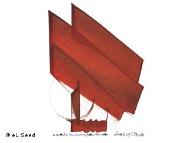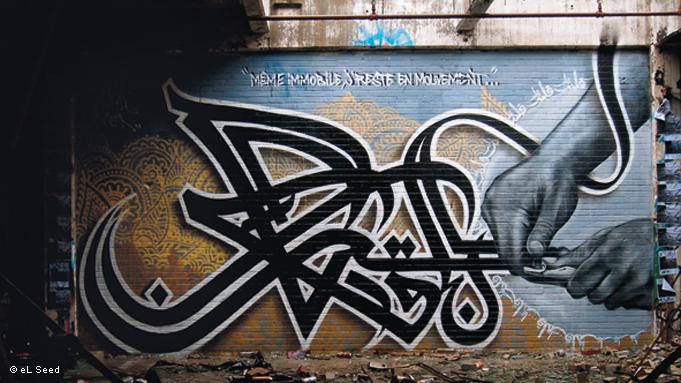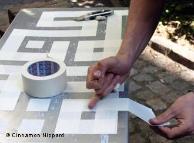Ancient calligraphy meets politics in modern Arabic graffiti
 The art of calligraphy is central to Arabic graffiti
The art of calligraphy is central to Arabic graffiti
Arabic artists push the boundaries of graffiti with their calligraphic styles and political messages.
Graffiti can be more than just a can of spray paint: It played a small part in the revolutionary change that swept the Arab world earlier this year. The uprising in Syria was incited by the arrest in early March of a group of children, aged 8 to 15, who had been caught spraying anti-government graffiti on the wall of their schoolhouse.
The children were released on March 20, reportedly showing signs of torture, and people took to the streets against the regime. Since then, human rights groups say that more than 1,000 people have been killed and 10,000 arrested.
’Be with the revolution’
Bildunterschrift: Tagging a name or pseudonym is the basis of graffiti in the Western world. While there are also taggers in Arab regions, according to Lebanese typographer Pascal Zoghbi, graffiti assumes a more urgent role as a means of voicing dissent. In this way, Arabic graffiti often takes the form of political slogans like «Be with the revolution», which spread from country to country during the recent uprisings.
Pascal Zoghbi remarked that it’s the easiest, fastest and virtually only way for a person living in an undemocratic state to express their opinion openly. «They cannot try it in a newspaper because of the censorship. Their blogs will be shutdown or the Internet will be closed», he said. «The government is really in control of everything they do, so it’s the only way they can make their voice heard».
Even though graffiti has been on the rise since the so-called Arab Spring, with political slogans appearing on the streets and even on tanks, if people are caught, the punishment in these oppressive nations can be a lot harsher than in the West.
The price of expression
In Syria, the security army removed the fingernails of teenagers who sprayed anti-government graffiti, while in Libya some of the protestors who took their message to the street with spray cans paid a much higher price.
«When they drew the resistance flag kicking out Gaddafi, they were shot by the security forces», said Zoghbi.
Lebanon is one of the few countries where graffiti is not illegal. Zoghbi said that as long as graffiti didn’t target a certain politician, or political party, it was ok. «But once you touch one of these big politicians or leaders, you might be in trouble», he added. «Not from the policemen, but from mafias there».
In terms of style, Lebanese artists are heavily influenced by New York graffiti from the 1980’s, while Zoghbi said that in other countries artists are more inspired by the natural flow of the Arabic script itself.
In Palestine, on the other hand, street art takes many forms, from political statements, to murals or stencils of martyrs.
The controversial barrier that Israel erected on the West Bank is a central theme used by Palestinian and internationally renowned artists like Banksy, Blu and Swoon to criticize Israeli policy. Many locals, however, are opposed to artistic representations of the wall because they think this makes it beautiful and therefore acceptable.
 Artist eL Seed partnered with Hest1 for this work, «Balance»
Artist eL Seed partnered with Hest1 for this work, «Balance»Art with a message
One of the most influential artists is French-born Tunisian eL Seed, who now lives in Canada. eL Seed has a very strong, clear calligraphic style, based on traditional Arabic scripts, but with a fresh, urban feel. He no longer tags his name on walls or signs his murals, but instead he has adopted a proverbial tradition where the message takes precedence. His large-scale pieces embody proverbs such as «Respect our elders», «Inspiration» (see the photo) and «I need my history».
«He really modernizes [the art form] or makes it urban so it appeals to the young graffiti writers in Beirut for example. Everybody knows him and likes his work», Don Karl, graffiti writer, said of eL Seed.
Artists like eL Seed tap into ancient traditions with their work. Like many alphabets around the world, Arabic can be traced back to 1300 BC to the Phoenicians who first developed phonetic characters. The Arabic alphabet itself originated around 500 BC. From the set of symbols, other calligraphic styles like Thuluth, Naskh, Farsi and Diwani developed. The smoother, curvilinear style was used in North Africa and Spain, while the Square Kufic style was used in the East.
Parisian connects with ancient script
L’Atlas is a Paris-based artist who caught the graffiti bug in the 80s and 90s, but looked further than the Latin alphabet he grew up with. Obsessed with letters, he began to study Chinese and Arabic calligraphy by himself. After meeting Arabic calligraphic masters, l’Atlas studied in Morocco, Egypt and Syria, and developed a passion for the Square Kufic script.
L’Atlas developed a new kind of alphabet, melding Latin letters into the geometric Kufic forms in an attempt to explore new visual possibilities and to bridge the gap between East and West.
 Removable tape keeps l’Atlas within the legal boundaries
Removable tape keeps l’Atlas within the legal boundaries
After being caught by police while doing graffiti in 2001, l’Atlas decided to start expressing his ideas legally by using gaffa tape on the ground. He began to create compasses in a cryptogram style, directly outside the subway exits in Paris in white gaffa tape, hoping to encourage people to question their personal direction in life.
«My way was just an example to ask people like the compass: ’Where are you going? What are you doing?’», explained l’Atlas.
The compass was also a representation of himself as an artist, who came from the underground and had to tackle the city and the art world. Within just a couple of years, everyone in Paris had heard of l’Atlas and his quest to bridge continents, eras, and art forms.
A musical script
There are clear similarities between Western and Arabic graffiti; in both genres, the letters are extended and intertwined. Zoghbi insists, however, that Arabic graffiti has a different feel to it.
«It’s more dancing than being structured together. It’s more a musical script», he described.
Source: Deutsche Welle
Calligraphy is the art of both ideal writing and an ideal soul.



